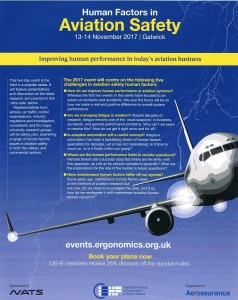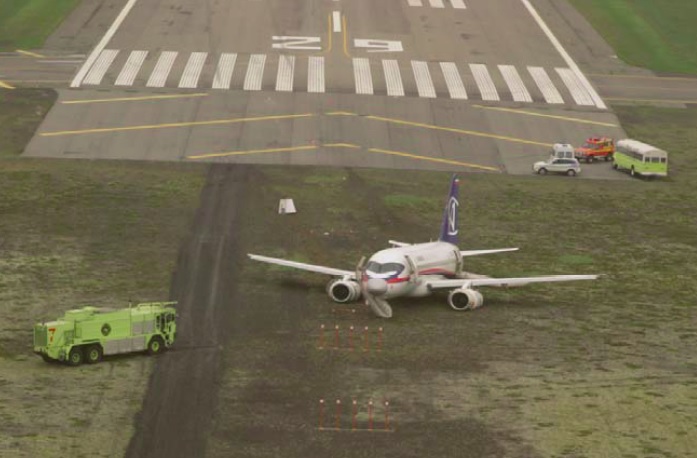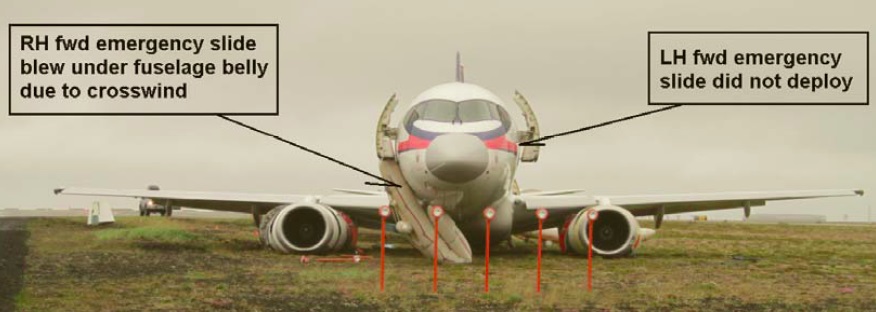Fatigued Flight Test Crew Crosswind Accident
The Icelandic Transportation Safety Board (ITSB), the RNSA, recently issued their report into a wheels up runway excursion accident that occurred on 21 July 2013 to Sukhoi RRJ-95B ‘Superjet 100’ 97005 during flight tests by Sukhoi at Keflavik airport.
The Flight Test Objective and the Accident Flight
The purpose of the flight test campaign was to expand the aircraft’s automatic approach capability from CAT II to CAT IIIA. Seven approaches and go-arounds with possible landing gear touchdown, had been conducted to RWY 20, followed by two to RWY 11. The RNSA explain that on the 9th approach:
…the flight crew intended to execute a go-around at 2-3 feet radio altitude over RWY 11, under crosswind conditions [>19.5 knots], near the airplane‘s maximum landing weight, with one engine inoperative.
Keflavik is a popular location for crosswind testing because of its exposed location and runways at 90ºs give a high probability of useful crosswind conditions.
When the aircraft was at radio altitude of 17 ft the Automatic Flight Control System (AFCS) at 05:23:25, in accordance with its programmed logic, commanded both throttles to IDLE. One second later, as per plan, at about 10 ft the test pilot sitting in the jump seat shut down the right engine using the ENG MASTER SWITCH. This disconnected the AFCS autothrottle on that engine, while the left engine continued to reduce thrust to IDLE. A further second later, at about 4 ft, the pilot flying disconnected the AFCS autopilot. This resulted in the left autothottle returning to SPEED mode and advancing the left throttle.
The pilot flying pressed the TOGA button on the right TQL [throttle lever] to initiate a go-around and, according to the cockpit voice recorder, called out “go-around”. Almost simultaneously, at 05:23:28.70, the main landing gear touched the RW and as a result of left main LG [landing gear] shock strut compression a/c avionics complex received WOW signal (weight on wheels) [for 0.4s].
However, in accordance with the Certification Specification for All Weather Operation (CS-AWO), after the WOW signal the left autothrottle disengaged (to prevent inadvertent selection of TOGA after landing), as did the AFCS flight director.
The pilot flying spotted this and started to perform a go-around in manual mode, but erroneously set the right (i.e. the inoperative) engine throttle lever to TOGA, pitched-up the aircraft and ordered landing gear retraction.
Consequently the aircraft started to loose speed, and having reached 27 ft stopped climbing and started to descend. The speed decreased further, below 120 knots and the pilot flying, reduced the pitch to prevent stalling. The “LANDING GEAR NOT DOWN” aural warning then triggered.
The pilot flying realized after about 15 s that he had been controlling the inoperative engine, just moments before the aircraft (still wheels up) hit the runway at 05:23:47. The aircraft skidded 1600 m down the runway, overran the runway and came to a stop at 05:24:25.
The RNSA comment:
Video recording from the cockpit provided the investigators with visual evidence showing the inoperative engine throttle lever being advanced during the go-around procedure, as well as showing the work load and the task division between the individual flight crew members.
During the evacuation the forward left door was opened, but as it had not been armed the emergency escape slide did not deploy. The forward right hand door was opened, and while the slide deployed, it was blown under the aircraft by the prevailing crosswind and was unusable. Te RNSA note that it should have still functioned as the crosswind was less that the 25 knots specified in EASA CS-25.810(iv).
A flight test engineer operating the test equipment in the cabin opened the rear left door and its slide deployed, so all five crew used that exit.
One crew member suffered a broken ankle during the evacuation. The underside of the fuselage and both engines and their nacelles received extensive damage.
Recovery operation:
Human Factors – Fatigue / Alertness & Pressure
The RNSA concluded “that human factors played a significant role in this accident”. In particular significant fatigue was evident.
The Russian Federal Aviation Regulation limits the duty period for test pilots (preflight preparation and test flight duration) to 8 hours. On the day, the commencement of flying has been slipped back several times. So whereas the first flight had been due at 14:00 it actually took off at 19:57, with the crew spending their time as follows.
-
8:30 -10:00 – preliminary preparations to flight in the hotel;
-
10:00 – 12:00 – rest in the hotel;
-
12:00 – 13:00 – lunch in the hotel;
-
13:00 – 18:00 – rest in the hotel;
-
18:00 – 18:30 – dinner in the hotel;
-
18:30 – 19:00 – transfer to the airport (start of shift according to Sukhoi);
-
19:00 – 19:35 – preflight training;
-
19:35 – 19:45 – transfer to the aircraft.
-
19:57 – 21:40 – first flight;
-
22:35 – 00:24 – second flight;
-
01:16 – 03:07 – third flight;
- 04:03 – c6:20 – fourth flight (ended at 05:23 with the accident).
The RNSA comment that each rescheduling had required some crew interaction during their rest period. They do not detail their previous night’s sleep though.
The accident occurred 10 hours and 53 minutes after the flight shift started and 20 hours and 53 minutes after the preliminary preparation started in the hotel at 08:30.
The ITSB [RNSA] concludes that although the flight crew was well rested prior to the originally planned flight duty time, it was not well rested at the time of the actual flight duty time due to significant and repeated delays.
This was done because the time for flight test campaign was about to finish and the weather forecast for the following 3 days did not have suitable weather conditions for the flight test program.
Additionally, the pilot flying has remained in Iceland during the test campaign (whereas other personnel had been rotated) and was on his 30th test flight in less than a month.
The RNSA note that:
Performance decrements associated with periods of prolonged wakefulness have been addressed in multiple research literature. Research has shown that performance on cognitive tasks, mental problem solving, vigilance and communication tasks shows a 30% decrement after 18 hours of wakefulness. After 42 hours, performance degrades by 60%. Performance degradation is therefore progressive, becoming worse as time awake increases.
Based on the above research and with respect to the preliminary flight preparation starting at 08.30 in the morning of July 20th, ITSB [RNSA] fatigue calculations estimated the task performance of the flight crew to have degraded approximately 46% at the time of the accident.
One of the more sensitive measures of performance degradation due to the fatigue associated with continuous wakefulness is reaction time. People who are fatigued, reliably react more slowly to situations and stimuli that require rapid cognitive or physical responses [as required for the accident flight test].
The accident occurred during night at 05:23, at the time of day when the performance and cognitive function of the pilot flying would have been at its low point…
An indicator of flight crew fatigue was that standard callouts were not made when initiating the go-around.
The pilot flying attempted the go-around with the use of the inoperative engine TQL and 15 seconds passed before he corrected this.
Emergency Response
The RNSA comment that:
The ATCO on duty in the tower…activated the airport’s fire department at 05:24:10. The airport’s emergency plan was not activated until 05:32:36.
This delay was identified as being partly due to the small number of people on board, the lack of a MAYDAY call from the aircraft and the absence of a fire (as prior exercises involved a fire being lit at the airport’s fire training area).
The ITSB [RNSA] determined this decision to be caused by insufficient Operational Awareness on behalf of the tower ATCO personnel.
Airport operator Isavia has since revised its training.
Other Regulatory Matters
RRJ-95B had 97005 received a Russian Experimental Aircraft Airworthiness Certificate and Test-Aircraft Certificate of Registration in August 2010. As it did not hold full International Civil Aviation Organization (ICAO) Certificate of Airworthiness (CofA), permission was therefore required to operate in Iceland. The RNSA found that the Icelandic Ministry of Foreign Affairs (MFA) erroneously defined the aircraft as a ‘State Aircraft’, based on diplomatic communications from the Embassy of the Russian Federation in Iceland which stated “Sukhoi Civil Aircraft of the Ministry of Industry and Trade of the Russian Federation” (our emphasis) and so approved the overflight in Icelandic airspace and landing in Iceland on that basis. The investigation:
…did not reveal any Icelandic audit, restriction or special approval provided in conjunction with the flight testing program of the accident aircraft at Keflavik Airport in Iceland, except the approved overflight in Icelandic airspace and landing in Iceland provided by the Icelandic Ministry of Foreign Affairs.
The MFA has since changed its process for handling such requests.
The flight testing of an airplane on RWY 11 would take the aircraft over the populated residential area of InnriNjarðvík, at minimum clearance altitude with one engine inoperative.
Isavia, has formed an in-house task group to examine procedures for the use of Keflavik airport for flight testing and will:
-
Consider the time of day these flights can be operated
-
Designate flight patterns, to ensure increased safety of the surrounding populated areas
-
Ensure that the airport has sufficient emergency equipment
-
Review the airport staff training
Safety Recommendations
Nine safety recommendation are made. Three to Sukhoi Civil Aircraft, three to Isavia, one to the Icelandic Transportation Authority, one to the Russian Ministry of Industry and Trade and one jointly to EASA and the Interstate Aviation Committee. In addition, one safety action is issued to the Icelandic Ministry of Interior.
Other Resources
You may find these previous Aerossurance articles on flight test and fatigue issues of interest:
- Breaking the Chain: X-31 Lessons Learned
- AC-130J Prototype Written-Off After Flight Test LOC-I Overstress
- Maintenance Check Flights: Safety Lessons
- Embraer ERJ 170 FMS Error & Fatigue
- US Police Helicopter Night CFIT: Is Your Journey Really Necessary?
- Maintenance Personnel Fatigue
- UPDATE 14 June 2017: Perception and Fatigue: CH124 Sea King Engine Failure
- UPDATE 20 August 2017: 1980 MD-81 Flight Test Accident Video
- UPDATE 3 July 2020: Fatigue Featured in Anchorage Alaska Air Ambulance Accident
UPDATE 19 May 2016: The Japanese Transport Safety Board (JTSB) release their report into a heavy landing incident during training in crosswinds on Bombardier Dash 8-200 JA801B of Oriental Air Bridge in Nagasaki in February 2014. UPDATE 30 December 2016: This was our 9th most popular article in 2016.
UPDATE 16 February 2017: Aerossurance is delighted to be sponsoring an RAeS HFG:E conference at Cranfield University on 9 May 2017, on the topic of Staying Alert: Managing Fatigue in Maintenance. This event will feature presentations and interactive workshop sessions.
UPDATE 14 March 2017: In an ISASI conference presentation the value of image recorders in this accident investigation was discussed.
UPDATE 25 June 2017: During an air ambulance positioning flight in Iceland an Impromptu Flypast Leads to Disaster. In this accident analysis of CCTV images from the ground proved critical.
UPDATE 26 September 2020: Fatal Fatigue: US Night Air Ambulance Helicopter LOC-I Accident
Aerossurance is pleased to be supporting the annual Chartered Institute of Ergonomics & Human Factors’ (CIEHF) Human Factors in Aviation Safety Conference for the third year running. We will be presenting for the second year running too. This year the conference takes place 13 to 14 November 2017 at the Hilton London Gatwick Airport, UK with the theme: How do we improve human performance in today’s aviation business? 





Recent Comments